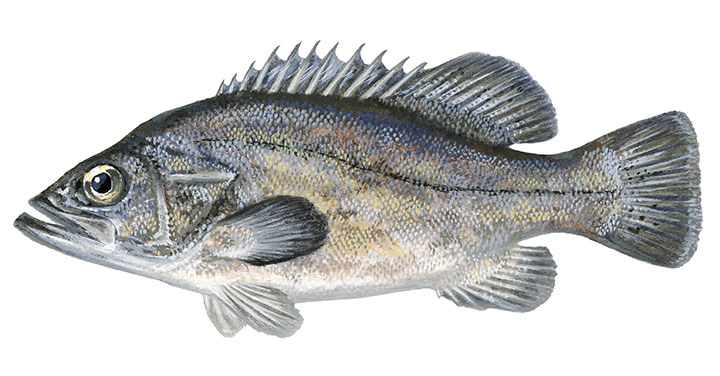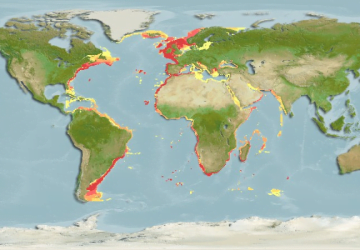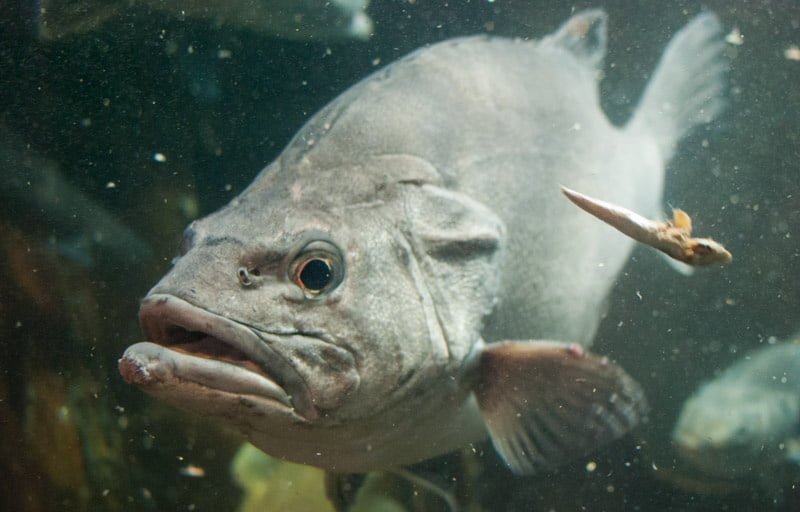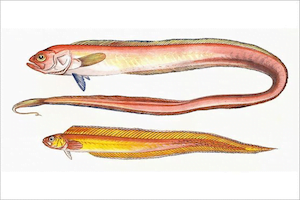Polyprion Americanus
– Atlantic Wreckfish –


| Conservation status |
|---|
 Data Deficient (IUCN 3.1)[1] |
| Scientific classification |
Polyprion americanus (Bloch and Schneider, 1801)
| Kingdom: | Animalia |
| Phylum: | Chordata |
| Class: | Actinopterygii |
| Order: | Perciformes |
| Family: | Polyprionidae |
| Genus: | Polyprion |
| Species: | P. americanus |


The Atlantic wreckfish, (Polyprion americanus), also known as the stone bass or bass groper, is a marine, bathydemersal, and oceanodromous ray-finned fish in the family Polyprionidae. It has a worldwide, if disjunct, distribution in the Atlantic, Pacific and Indian Oceans.
The Atlantic wreckfish is a large fish with a deep, robust body and a large head with a protruding lower jaw. The two dorsal fins are joined, the first has 11 spines with the final spine joined on to the second dorsal fin, which has 12 branched rays. The anal fin has a short base and has three robust spines. The caudal fin is broad and square. The body is covered with small, firmly attached scales which run up the base of the dorsal and anal fin. It has a large mouth and eyes. The preoperculum has a spiny margin while the operculum has a thick bony strut running horizontally at eye level which terminates in a spine. The back and flanks are dark brown in colour with darker spots and blotches fading to yellowish on the belly.[3] They have also been described as being Wreckfish are bluish grey on the back with a paler silvery sheen on the underside. The fins are blackish brown.[4] The maximum total length is 210 centimetres (6.9 ft) with a maximum published weight of 100 kilograms (220 lb).[2]
The body of the cernier is oval , quite tall and robust, covered with small scales. It has a single bilobed dorsal fin , its caudal fin is rounded.
Its massive head has a concave forehead and a bump behind the eye . The latter is very large with an almost round pupil. Its lower jaw is longer than the upper jaw.
A strong horizontal bone ridge is visible on the upper part of the operculum, the pre-operculum are serrated.
The juveniles have a black or purplish coloration marbled with white-pink, their body is somewhat stockier in appearance than the adult. Adults display a more uniform, dark brown to silvery gray coat with reddish reflections.
Its size varies between 60 and 80 cm for young individuals, visible when diving; adults can reach 2 m (max. 210 cm for 100 kg).
Distribution
The Atlantic wreckfish has a disjunct world wide distribution. It is found in the eastern Atlantic Ocean from Norway to South Africa, into the Mediterranean and including the Macaronesian Islands and Tristan da Cunha. In the western Atlantic it is found off the eastern coast of North America from Newfoundland to North Carolina.[2] It also occurs in the western South Atlantic off Argentina, Uruguay and southern Brazil, as well as the Falkland Islands.[1] In the western Indian Ocean it occurs around Île Saint-Paul and Île Amsterdam and in the southwestern Pacific Ocean it is found around New Zealand.[2] It is also found off southern Australia from just north of Perth, Western Australia to Fraser Island in Queensland, including Tasmania.[5]
Habitat and Biology
Adult Atlantic wreckfish occur around in caves, over rocky substrates and areas with densely scattered boulders, natural reefs and shipwrecks, a habitat which has led to species’ common name. The adults are deep water fishes which have been recorded at depths between 200 and 600 feet (61 and 183 m). It is normally a solitary species but the adults gather to breed during the summer. The juveniles form shoals for protection from predators which swim and hunt small fish in mid-water. Once the attain a length of 50–75 centimetres (20–30 in) the become solitary and look for a territory on the bottom. It is thought that the Atlantic wreckfish can live for as much as ninety years. They feed mainly on bottom dwelling fish, squid and cuttlefish but they will also take crustaceans and octopuses. They are probably best described as opportunistic, with one record of a ROV camera filiming a large congregation of small sharks feeding on a dead swordfish, with one of them being caught and swallowed whole by this species of wreckfish.
They have no known predators as adults, but juvenile specimens may be threatened by large bony fishes or sharks. [6]
Conservation and Usage
The Atlantic wreckfish is a commercially valuable species and is valued as a food fish in some parts of its range. Large wreckfish may be divided into steaks, while smaller fish are filleted or baked whole. In North and South America wreckfish are sold in frozen in supermarkets or grocery stores or marketed fresh from fish counters. They are caught in trawlers nets or by long lines and gill nets, or occasionally by small-scale fisheries which use rod and line. Overall the stock is assessed by the IUCN as data deficient but some stocks, such as the Mediterranean stock have been assessed as being at greater risk.[6]
From the coast up to 1000 m deep, demersal fish * on rocky or sandy-muddy bottoms, especially between 40 and 400 m.
The adults are solitary, in depth, the young are gregarious, epipelagic *, often under floating objects (hence the names in English and German, and the local name of “old wood”) or under pontoons.
Similar Species
A closely related species, Polyprion oxygenios (hapuka), lives only in the southern hemisphere, has a slender profile and triangular caudal.
The other two cerniers, Polyprion moeone and Polyprion yanezi , live offshore in the southern Pacific.
The brown grouper Epinephelus marginatus has a fairly similar general shape, but the forehead less concave and no hump on the head. It is found closer to the edge and at shallower depth, and likes holes and faults. Her dress is more brown with small scattered light spots. Badèche Epinephelus costae
is smaller, with a more slender shape, 4-5 longitudinal dark lines and a golden patch behind the head.
Alimentation
The diet of juveniles is made up of small preys attracted by floating objects: young fish, isopod crustaceans, etc.
Adults feed on cephalopods, fish and crustaceans living near the bottom or on the bottom.
Reproduction
Unlike groupers and badeches which are hermaphrodites *, cerniers are gonochoric *, without sexual dimorphism *. The animals are mature between 60 cm and 90 cm in length (5 to 15 years), and then begin a vertical migration to go to live on the deep sea. This migration is accompanied by morphological changes: the diameter of the eye increases and the body becomes rounded. A few egg-laying areas have been recorded in the Atlantic, in particular off South Carolina, north of the Azores and in the Sargasso Sea, in rocky reliefs between 400 and 800 m deep. The breeding season takes place from winter to spring, sometimes later (Sargasso, New Zealand). The female then produces several million eggs 1 to 1.5 mm in diameter. Upon hatching, the larvae are 3-4 mm in length and have a very large mouth. The eggs and larvae are pelagic, and could be carried by the Gulf Stream towards the east Atlantic coast in 4 to 9 months, which explains the greater frequency of juveniles in the east Atlantic. The adults would then return to the western Atlantic to breed.
Associated Life
A few external parasites have been described in the cernier in the Atlantic, notably the monogenic flatworm Calicobenedenia polyprioni (on the skin and eyes), and the copepod crustacean Jusheyus shogunus (on the gills), the latter previously identified in Polyprion oxygenios in the Pacific .
Various Biology
The age of a 126 cm individual was estimated at 76 years from thin sections of the otoliths *. Three genetically distinct groups have been identified: North Atlantic-Mediterranean, Brazil and South Pacific.
The flesh of the cernier is fine, refined, sometimes marketed under the name of grouper. Catches are however decreasing in the main fishing areas, suggesting that stocks are already in a situation of overfishing. According to a European directive (Council Regulation (EC) n ° 1967/2006 of December 21, 2006 concerning management measures for the sustainable exploitation of fishery resources in the Mediterranean), the minimum catch size of this fish is 45 cm.
Because of its value, its large size and its rapid growth at the start of its life (1.5 kg in 15 months), the cernier could be a good candidate for fish farming, experiments in progress, especially since it tolerates captivity well: it is often the host of large public aquariums. However, it has not yet been able to be reproduced experimentally, which prevents breeding for the moment.
Further Information
The only ones generally encountered by divers, young cerniers are easy to approach as they do not stray much from their floating shelter.

































































































































































































































